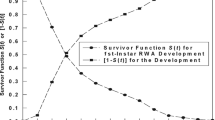Abstract
THERE are two aspects of the regulation of animal numbers: first, how the numbers in a population are controlled around a mean level over a number of generations and second, how this mean level is determined. Studies on the dynamics of insect populations leading to the construction of life tables are frequently confined to a particular location where the fecundity and mortality of successive generations are estimated1–3, and this approach emphasises the first aspect. Varley1 appreciated the value of obtaining permanent traces of the insects as they passed from one instar to another (galls, emergence holes, exuviae), since such direct counts of the numbers entering an instar avoided the time-consuming and inaccurate process of integrating successive estimates of population size4. The traces are analogous to a natural accumulative trap. Beaver5 and Danks6 used this ‘trace’ method for bark beetles and various solitary Aculeata. Freeman7 extended the trace method to accumulated generations at each of several sites, an approach which emphasises the second aspect of population dynamics.
This is a preview of subscription content, access via your institution
Access options
Subscribe to this journal
Receive 51 print issues and online access
$199.00 per year
only $3.90 per issue
Buy this article
- Purchase on Springer Link
- Instant access to full article PDF
Prices may be subject to local taxes which are calculated during checkout
Similar content being viewed by others
References
Varley, G. C., J. anim. Ecol., 16, 139–87 (1947).
Richards, O. W., and Waloff, N., Phil. Trans. R. Soc., B 224, 205–57 (1961).
Varley, G. C., and Gradwell, G. R., Insect Abundance (edit. by Southwood, T. R. E.), Symp. R. Ent. Soc. Lond., 4, 132–42 (1968).
Southwood, T. R. E., Ecological Methods (Methuen, London, 1966).
Beaver, R. A., J. anim. Ecol., 35, 27–41 (1966).
Danks, H. V., J. anim. Ecol., 40, 79–82 (1971).
Freeman, B. E., J. anim. Ecol., 42, 173–182 (1973).
Freeman, B. E., and Parnell, J. R., J. anim. Ecol., 42, 779–784 (1973).
Freeman, B. E., Carib. J. Sci., 14, 115–124 (1974).
Freeman, B. E., and Jayasingh, D. B., Oikos. 26, 86–91 (1975).
Freeman, B. E., and Taffe, C. A., Oikos, 25, 388–394 (1974).
Varley, G. C., and Gradwell, G. R., J. anim. Ecol., 29, 399–401 (1960).
Author information
Authors and Affiliations
Rights and permissions
About this article
Cite this article
FREEMAN, B. A spatial approach to insect population dynamics. Nature 260, 240–241 (1976). https://doi.org/10.1038/260240a0
Received:
Accepted:
Issue Date:
DOI: https://doi.org/10.1038/260240a0
This article is cited by
-
Population studies and conservation of Jamaica’s endangered swallowtail butterfly Papilio (Pterourus) homerus
Journal of Insect Conservation (2008)
Comments
By submitting a comment you agree to abide by our Terms and Community Guidelines. If you find something abusive or that does not comply with our terms or guidelines please flag it as inappropriate.



